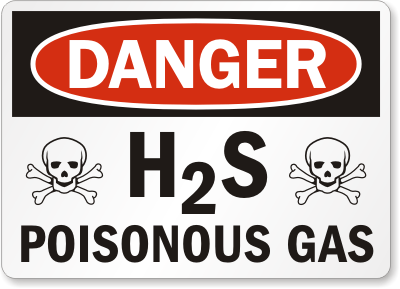
Hydrogen Sulfide (H2S) Poison to People, Poison to Plants
Hydrogen Sulfide (H2S) is a colorless gas that smells like rotten eggs (from the sulphur). Often referred to as “sewer gas,” hydrogen sulfide is highly poisonous. Usually, the poisoning caused by hydrogen sulfide is through inhalation and has a toxicity similar to cyanide. Anaerobic conditions produce hydrogen sulfide (H2S), methane, ammonia and carbon dioxide. H2S is the most dangerous. In humans, one or two breaths of air, with as little as 600 parts permillion (ppm) H2S, can cause a person to lose consciousness. Deaths are not uncommon when people enter poorly ventilated spaces such as deep wells, underground tanks or sewer systems. Since H2S gas is heavier than air, its concentration is highest near the bottom of enclosed spaces.
What happens to hydrogen sulfide when it enters the environment?
• Hydrogen sulfide is released primarily as a gas and will spread in the air
• When released as a gas, it will form sulfur dioxide and sulfuric acid in the atmosphere
• Sulfur dioxide can be broken down further and is a major component in acid rain
• Hydrogen sulfide remains in the atmosphere for about 18 hours
• In some instances, it may be released as a liquid waste from an industrial facility
Low Levels of H2S
The odor of hydrogen sulfide gas can be perceived at levels as low as 10 ppb (parts per billion). At levels of 50-100 ppm (parts per million), it may cause the human sense of smell to fail. Exposure to lower concentrations can result in eye irritation, a sore throat and cough, shortness of breath, and fluidin the lungs. These symptoms usually go away in a few weeks. Long-term, low-level exposure may result in fatigue, loss of appetite, headaches, irritability, poor memory, and dizziness.
High Levels of H2S
At high exposures (usually greater than 300 ppm), H2S has the amazing effect of causing the nose to stop perceiving its smell after a few inhalations, which may lead to the inhalation of a toxic or fatal dose (which can occur at 600 ppm). Breathing very high levels of hydrogen sulfide can cause death within just a few breaths. There could be loss of consciousness after one or more breaths. At high levels, hydrogen sulfide gas may paralyze the lungs, meaning that the victim may then be unable to escape from the toxic gas without assistance.
Continued exposure to H2S will kill you!
When released suddenly in large amounts of if allowed to build up in confined or poorly ventilated areas, toxic gases such as H2S are deadly. Every year people are killed or injured by poisonous H2S gas.
The hazard increases when:
• gases concentrate or build up in a confined space, or are suddenly release in a work environment
• delays in emptying pits or tanks cause manure levels to rise, bringing trapped gases closer to any workers examining a pit or tank
• hot weather speeds anaerobic conditions, thus increasing the amount of H2S being produced
Sources: Agency for Toxic Substances and Disease Registry (ATSDR), Atlanta, GA. 1999 Manning Safety Services, Inc., Jourdanton, TX
